Fun Ways to Teach Colors to Toddlers: Activities Preschoolers Love
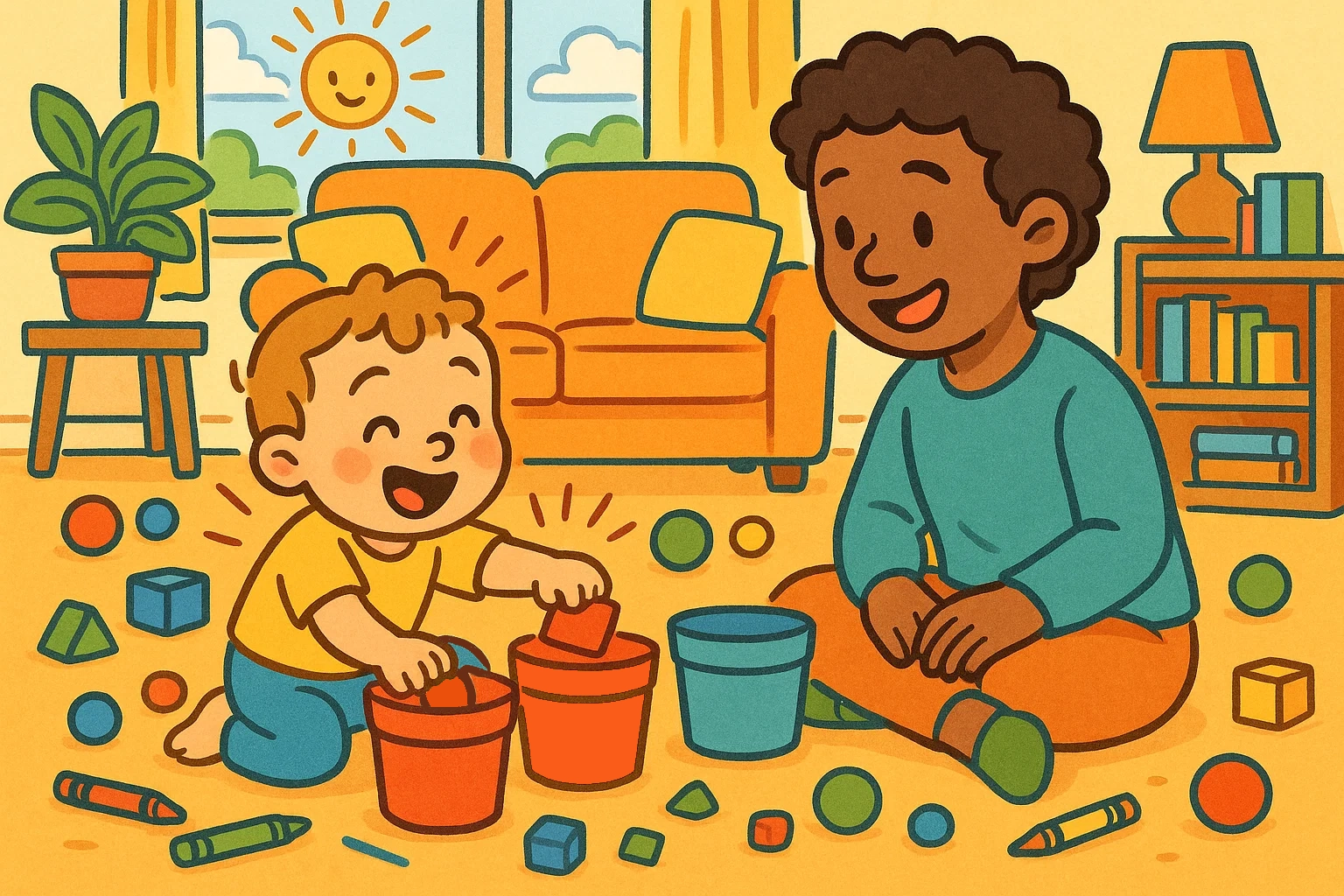
Teaching colors to toddlers opens up a vibrant world of learning that extends far beyond simply naming hues. When children learn about colours, they develop cognitive skills, expand their vocabulary, and begin making sense of their environment in meaningful ways. This comprehensive guide explores effective, research-backed strategies to help your toddler master recognition of different shades through engaging activities they’ll genuinely enjoy.
Importance of Early Color and Shape Learning
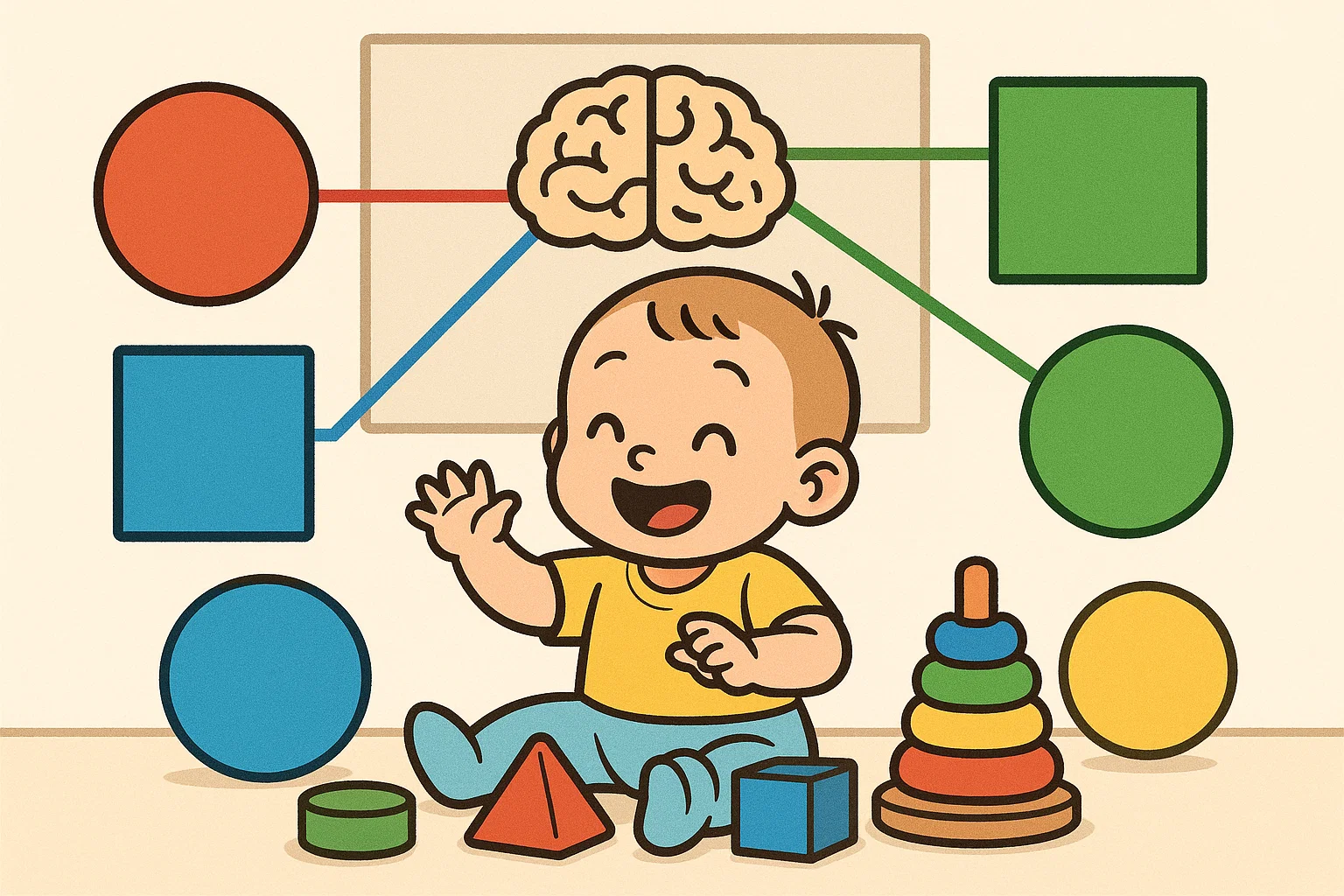
Early childhood educators and developmental psychologists consistently emphasize that learning colours and shapes during the toddler years lays the foundation for more complex cognitive skills. These concepts serve as building blocks for mathematical thinking, language development, and problem-solving abilities.
Benefits of Early Color Perception in Toddlers
When toddlers learn to identify and name different colors, they’re doing much more than memorizing labels. Research published in the SpringerOpen suggests that early learning of this type enhances categorization skills and visual discrimination abilities. Children who develop strong recognition skills often demonstrate improved attention to detail and pattern recognition.
This type of learning also strengthens the connection between visual perception and language. As your little one begins to associate words with specific visual experiences, they build neural pathways that support literacy development later on. One study found that children with advanced vocabulary in this area at age two showed stronger reading readiness at age five.
How Colors and Shapes Help Kids Organize Their World
Think about how often we use these concepts to organize information in daily life—coded calendars, traffic lights, warning signs. When children learn these concepts, they gain tools to categorize and understand their surroundings. A toddler who can identify that apples are red, bananas are yellow, and grapes are purple is practicing classification skills that will eventually support scientific thinking.
Shapes and colors work together to help kids make sense of objects. Your child might first notice “a ball” as simply round, but as they develop, they’ll distinguish “the red ball” from “the blue ball,” demonstrating increasingly sophisticated observational abilities.
Brain Development Through Color Learning
When a toddler sorts colored blocks, they’re activating visual processing centers, motor control regions, and language areas of the brain all at once. This integrated activity promotes the development of executive function skills such as working memory, cognitive flexibility, and self-control.
The Value of Teaching Color Names and Vocabulary
Naming the colours provides toddlers with descriptive vocabulary that makes communication more precise and expressive. Instead of saying “I want that one,” a child who knows these terms can say “I want the blue crayon.” This specificity reduces frustration and builds confidence in verbal expression.
Research posted on Sage Journals suggest that children from language-rich environments heard approximately 30 million more words by age three compared to peers in less verbal households. Teaching this vocabulary contributes to this crucial language exposure, particularly when parents engage in conversations rather than simple drills.
When to Start Teaching Children Colors
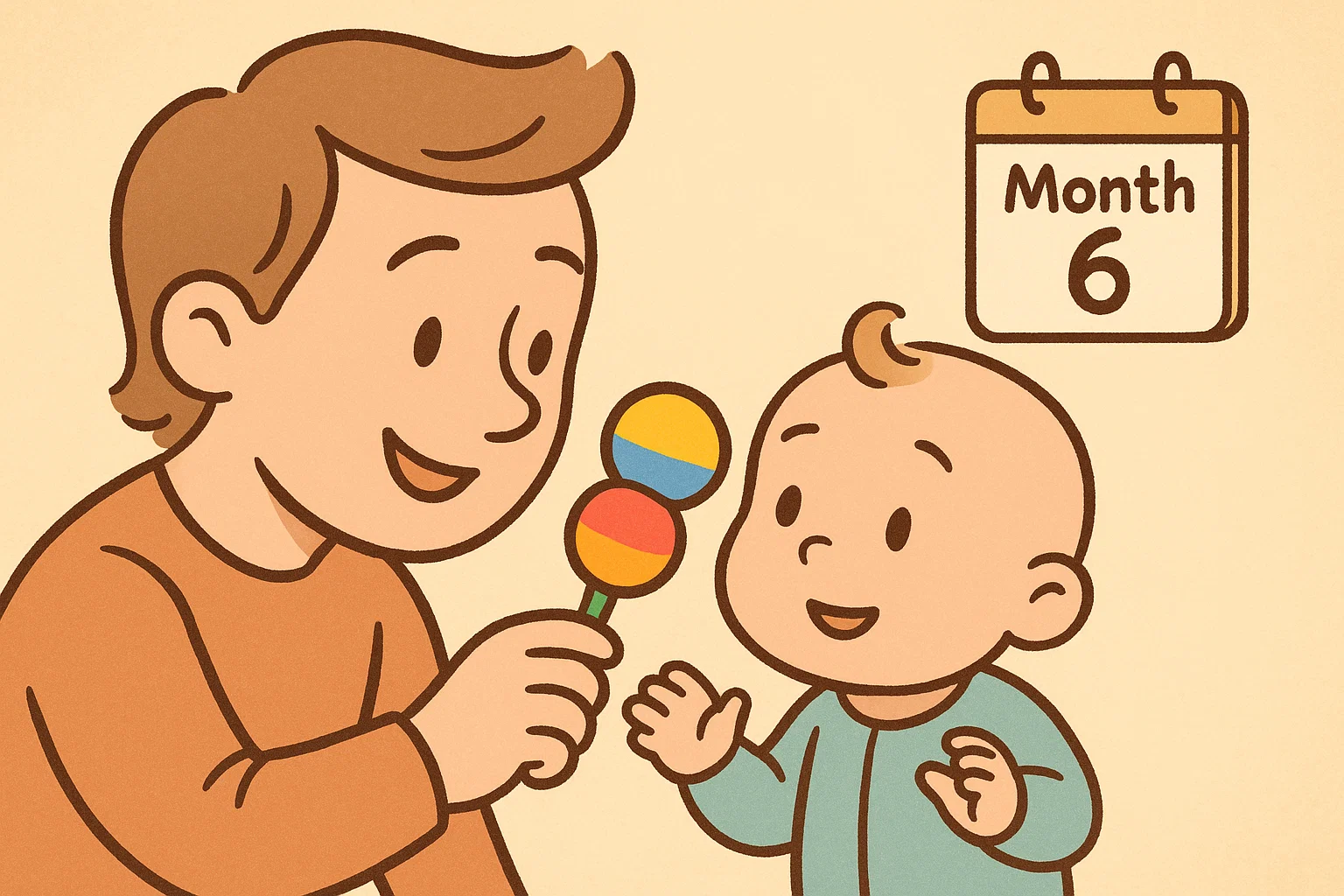
Understanding the developmental timeline for vision helps parents set realistic expectations and choose age-appropriate teaching methods.
When Babies Begin to Distinguish Colors
Newborns initially see the world in shades of gray, with limited ability to distinguish between hues. According to the American Optometric Association, babies start developing this type of vision around two to three months of age. By five months, most infants can differentiate between primary colours like red, blue, and yellow, though their perception isn’t as refined as adult vision.
At this early stage, babies respond particularly well to high-contrast options and bold patterns. Black and white images with bright accents capture their attention and support visual development.
Key Milestones in Color Vision Development
Understanding typical developmental milestones helps you recognize when your child is ready to start learning names for different shades:
| Age Range | Vision Milestone |
| 2-3 months | Begin distinguishing basic hues |
| 5-7 months | Can see the full spectrum |
| 12-18 months | Show preference for bright colours |
| 18-24 months | May start matching by shade |
| 2-3 years | Begin naming consistently |
| 3-4 years | Can identify and name most basics |
It’s important to note that these are general guidelines. Many toddlers show individual variation in when they master these concepts, and this variation is completely normal.
Optimal Age to Introduce the First Color
Most toddlers are ready to start learning names between 18 and 24 months, though meaningful understanding typically develops between ages two and three. The key indicator of readiness isn’t necessarily age but rather your child’s interest in visual differences and their language development stage.
Dr. Laura Jana, pediatrician and author of The Toddler Brain, notes that “readiness signs include pointing to objects when you name them, following simple instructions, and showing interest in sorting or grouping similar items.” If your toddler exhibits these behaviors, they’re likely prepared to begin the learning process.
Basics: Primary and Secondary Colors
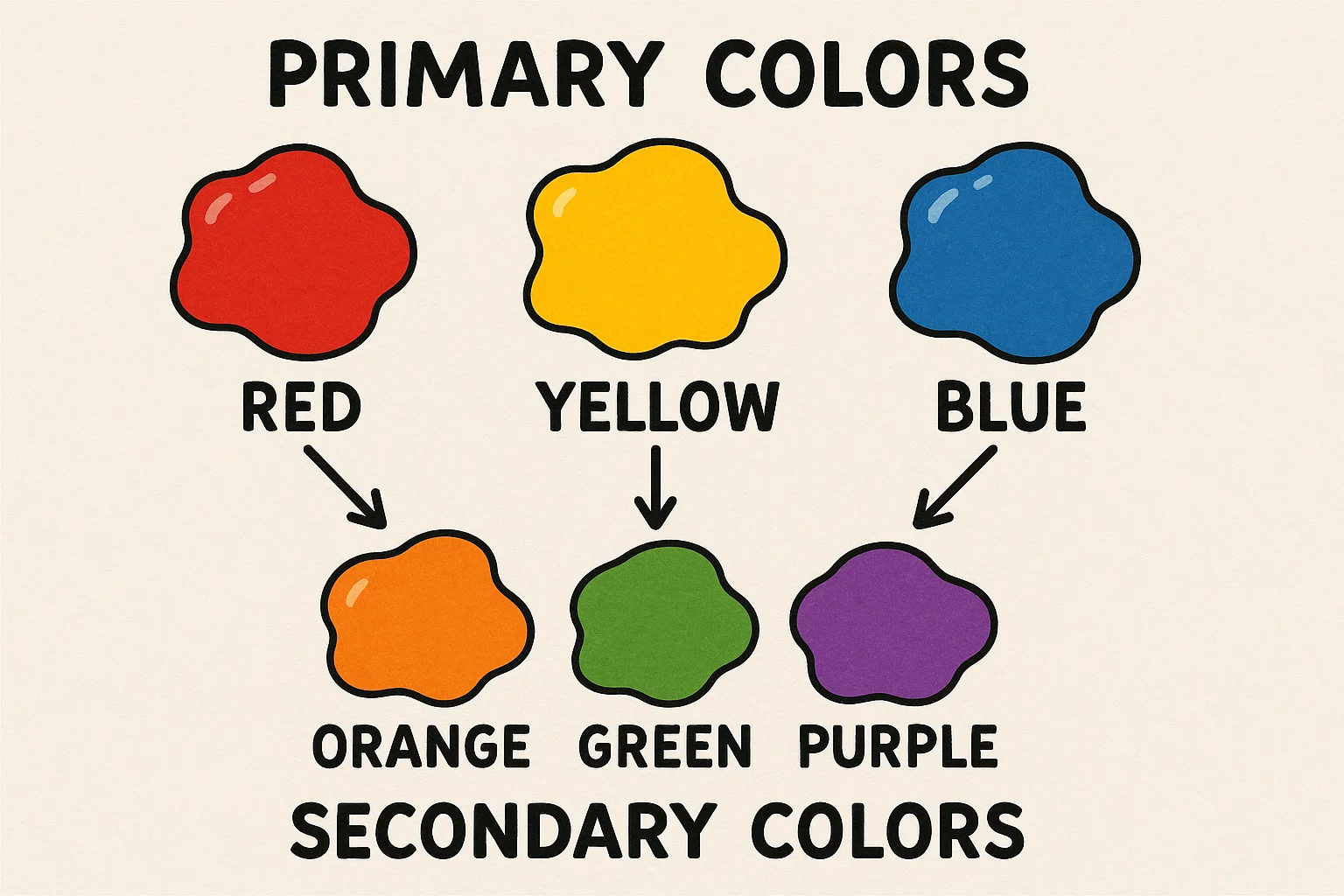
Building a solid foundation with basic options creates a framework for more advanced concepts later.
Introducing Primary Colors
Start with the three primary colors: red, blue, and yellow. These hues cannot be created by mixing others, making them fundamental to understanding. Begin with one color at a time rather than introducing all three simultaneously. This focused approach prevents overwhelming your little one and allows for deeper understanding.
When teaching each primary shade, immerse your child in examples. Point out a red apple during snack time, read books featuring red objects, and provide red toys for play. Research posted on Wiley Online Library shows that context-rich learning produces better retention than isolated memorization.
Teaching Secondary Colors
Once your child confidently identifies primary colours like red, blue, and yellow, introduce secondary options: green, orange, and purple. These are created by mixing two primaries, a concept that fascinates many preschoolers.
Secondary Basics:
- Green = Blue + Yellow
- Orange = Red + Yellow
- Purple = Red + Blue
Rather than presenting these as abstract facts, let children discover these relationships through hands-on mixing activities. This experiential learning creates memorable connections.
Teaching Tertiary Colors
Tertiary options (red-orange, yellow-orange, yellow-green, blue-green, blue-purple, and red-purple) result from mixing primary and secondary hues. These concepts are typically appropriate for older toddlers and preschoolers who have mastered basic recognition.
At this stage, focus on helping children notice subtle differences. They might observe that a red apple looks slightly different from a dark red tomato, or that light green grass differs from dark green leaves.
Mixing Colors to Create Secondary Colors
Hands-on mixing provides a concrete demonstration of how hues relate to each other. Using washable finger paints, let your child experiment with combining small amounts of primary shades. This activity serves multiple purposes: it teaches concepts, develops fine motor skills, and introduces basic scientific thinking about cause and effect.
“I never imagined my three-year-old would be so excited about purple,” shares parent educator Maria Chen. “But when she mixed red and blue paint herself and saw purple appear, her face lit up. She understood that she had created something new.”
The Value of Introducing One Color at a Time
Choose one color and spend several days or even a week focusing on it before introducing the next. During this time, point out that specific shade throughout your daily routines, provide toys and materials in that hue, and read books featuring it prominently.
Effective Ways to Teach Colors to Toddlers
Practical, everyday strategies make learning a natural part of your child’s routine rather than a forced educational exercise.
Using Flashcards to Teach Toddler Colors
Flashcards remain a useful tool when used thoughtfully. Rather than drilling with them in isolation, incorporate cards into conversations and play. Show one with a blue circle and say, “This is blue. Can you find something blue in our room?” This approach transforms flashcards from a rote memorization tool into a springboard for exploration.
Create your own using construction paper, photos of familiar objects, or printed images. Homemade versions featuring items from your child’s daily life often generate more engagement than generic commercial options.
Sorting Objects for Color Learning
Sorting activities naturally appeal to toddlers’ developmental stage. Between ages two and three, children demonstrate a strong drive to organize and categorize their world. Capitalize on this inclination by providing sorting opportunities throughout the day.
Simple Sorting Activities:
- Toy Sort: Gather blocks, small toys, or household items in various shades. Provide containers or sort the different colored items into separate piles.
- Laundry Helper: As you fold clothes, ask your child to help by sorting items—a practical task that reinforces recognition.
- Snack Sorting: During meals, sort colorful foods. Separate different fruit pieces or organize crackers by shade.
Sorting games develop multiple skills simultaneously. As children sort the different colored objects, they practice visual discrimination, fine motor control, and decision-making.
Pointing Out Colors You See Throughout the Day
Informal commentary during daily activities provides repeated exposure without feeling like structured lessons. “I see a yellow school bus!” or “Your socks are green today” keeps vocabulary present in your child’s environment naturally.
According to speech-language pathologist Dr. Rachel Coleman, “Narrating your day creates countless learning opportunities. Talk about what you see during walks, at the grocery store, while cooking—anywhere you go together. This repetition in varied contexts helps toddlers learn to generalize concepts across different situations.”
Using Everyday Tasks to Teach Colors
Transform routine activities into learning opportunities:
- Meal Preparation: “Let’s wash the red tomatoes. Can you hand me an orange carrot?”
- Getting Dressed: “Which shirt do you want to wear—the blue one or the green one?”
- Bath Time: “Let’s play with the yellow duck and the pink boat.”
- Outdoor Time: “Look at all the bright colours in the flowers. I see purple and white.”
These moments make learning feel effortless because they’re woven into activities your child already enjoys.
Applying Repetition for Learning the Colors
Repetition doesn’t mean boring drills. It means revisiting concepts in various, engaging contexts. Research posted on frontiers shows that children need multiple exposures to new information before it solidifies into long-term memory.
The key is varying how you present repeated information. On Monday, read a book about red objects. On Tuesday, paint with red paint. On Wednesday, hunt for red items around the house. Each activity reinforces the same concept through a fresh, engaging approach.
Fun Activities to Teach Colors to Preschoolers
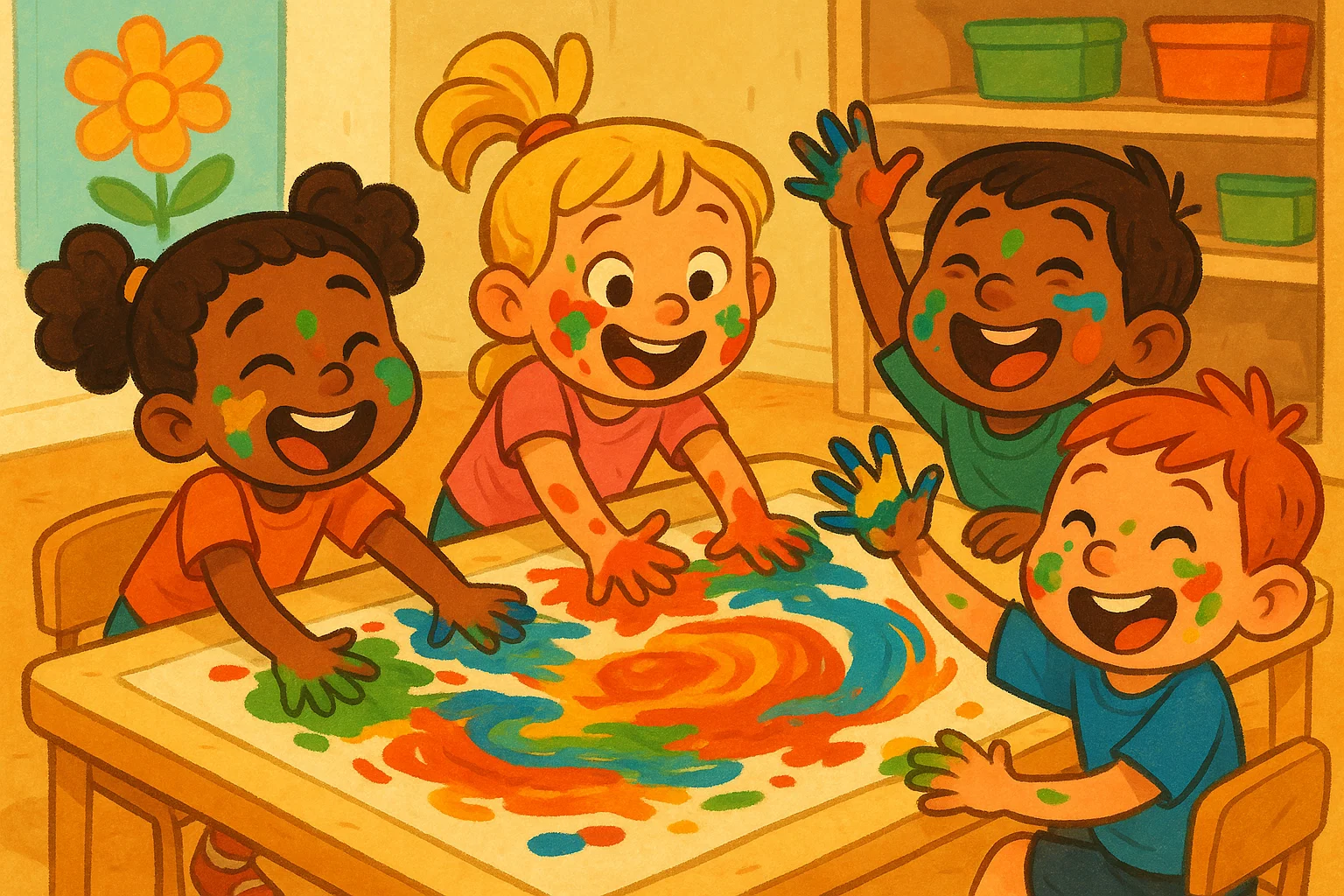
Active, playful activities maintain children’s engagement while building knowledge effectively.
Finger Painting Fun Activity
Finger painting offers sensory-rich exploration that kids love. This activity develops fine motor skills while teaching concepts and encouraging creative expression. Provide primary shades and let your child discover what happens when they blend on paper.
For easier cleanup, try painting in zippered plastic bags. Place paint inside, seal securely (tape the closure for extra security), and let your child squish and mix without mess. This variation works particularly well for younger toddlers still exploring through taste.
Color Sorting Games
Turn sorting into an exciting game by adding challenges appropriate to your child’s skill level. Beginners might sort objects into two categories, while older toddlers can manage four or more simultaneously.
Sorting Game Ideas:
- Pompom Sort: Using colored pompoms (available at craft stores) and muffin tins, have children place each pompom in the matching tin section.
- Button Jar: Collect buttons in various shades and sort them into small containers.
- Nature Collection: During outdoor time, collect natural items like leaves, flowers, or stones and sort by appearance back home.
According to occupational therapist Jennifer McCarthy, “Sorting activities are great for learning and also develop the pincer grasp, hand-eye coordination, and concentration—skills essential for future writing and self-care tasks.”
Color Scavenger Hunt
Scavenger hunts transform learning into adventure. Choose one color and challenge your child to find items matching that shade throughout your home or yard. For younger children, limit the search area and number of items. Older preschoolers enjoy more extensive hunts with specific item requirements.
Create simple picture lists showing items to find, or for pre-readers, use swatches they match to objects they discover. This fun activity gets kids moving.
Creating Color Sensory Bins
Sensory bins provide open-ended exploration opportunities that appeal to toddlers’ natural curiosity. Fill a large container with a base material (rice, dried beans, or sand) dyed in one shade, then hide objects of the same hue for your child to discover.
You can create thematic bins—a blue ocean bin with blue-dyed rice and sea creature toys, or a green jungle bin with green materials and toy animals. These engaging activities combine sensory play with reinforcement of visual concepts.
Shapes and Colors Puzzles
Puzzles that incorporate both shapes and visual recognition provide dual learning opportunities. Look for puzzles where children must match pieces by both shape and shade, building visual discrimination skills and problem-solving abilities.
Start with simple three- to five-piece puzzles for beginners, progressing to more complex designs as skills develop. The best puzzles feature familiar objects in clear, recognizable hues.
Advanced Color Concepts for Kids
Once children master basic recognition, you can introduce more sophisticated concepts.
Teaching Color Shades
Understanding that hues come in different shades represents a conceptual leap for young children. Start by comparing two different shades of the same base side by side. Show light green and dark green objects, asking your child to describe how they’re similar and different.
Use everyday observations to build this understanding: “This is a light blue sky, but at night the sky turns dark blue.” Creating gradients with paint or markers helps children visualize the continuum within a single family.
Teaching Color Opposites and Contrasts
Opposites (complementary options on the wheel) and contrasts provide foundational art concepts. Show how some stand out dramatically when placed together—yellow and purple, red and green, blue and orange.
This concept has practical applications: “When we want to make a sign that people notice, we might use options that are opposites, like yellow letters on a purple background.” Help your child observe contrasts in picture books, clothing combinations, and their environment.
Color Categories
As language skills advance, introduce categories—warm colors (reds, oranges, yellows) and cool colors (blues, greens, purples). Discuss how warm options might remind us of fire or sunshine, while cool ones bring to mind water or shade.
This categorization helps children think more flexibly and begins developing abstract thinking skills. A four-year-old who understands that both red and orange are “warm” demonstrates sophisticated classification ability.
Science Experiments with Color
Simple experiments transform learning into scientific exploration:
Walking Water Experiment: Place cups of colored water beside empty cups with paper towels connecting them. Children observe as water “walks” up the paper towel and into empty cups, mixing where they meet.
Density Tower: Layer liquids of different shades and densities (honey, dish soap, water, oil) in a clear container. Children observe how they separate based on physical properties.
Chromatography: Use coffee filters and washable markers to separate pigments and discover which combine to create each hue.
These experiments satisfy preschoolers’ growing curiosity about how things work while reinforcing concepts through memorable experiences.
Important Tips for Teaching Colors to Toddlers
Successful teaching requires patience, flexibility, and attention to your individual child’s needs and learning style.
Starting with the Basics of Color Learning
Begin simply with options your child encounters frequently. Red, blue, yellow, and green—the most common in children’s toys and environments—make ideal starting points. Master these four before expanding to additional hues.
Avoid overwhelming your toddler by introducing too many simultaneously. The goal is understanding, not memorization. When your child truly grasps what “red” means—recognizing it across different objects, lighting conditions, and contexts—they’ve achieved genuine learning.
Encouraging Curiosity and Exploration in Your Toddler
Follow your child’s interests rather than imposing a rigid curriculum. If your toddler becomes fascinated with purple, lean into that interest even if it wasn’t your planned “shade of the week.” Children learn most effectively when they’re genuinely curious about the subject.
Create opportunities for self-directed exploration. Provide art materials, building blocks, and toys in various shades without directing how they should be used. Often, children will spontaneously create their own sorting games or combinations, demonstrating that learning is happening organically.
Color Blindness Awareness: Early Identification and Support for Preschoolers
Approximately 1 in 12 males and 1 in 200 females experience some form of vision differences, most commonly red-green challenges. If your child consistently struggles with differentiation despite repeated teaching, or if there’s a family history, consider consulting your pediatrician or a pediatric ophthalmologist.
Early identification doesn’t change vision, but it helps parents and educators adjust teaching strategies. Children with these differences benefit from approaches that don’t rely exclusively on hue for learning—using shapes, patterns, and positions alongside colors provides alternative ways to categorize and understand information.
Teachers should be informed about a child’s vision differences to ensure classroom activities don’t inadvertently disadvantage them. For example, coded math manipulatives should also differ in shape, and seating charts shouldn’t rely solely on zones identified only by shade.
